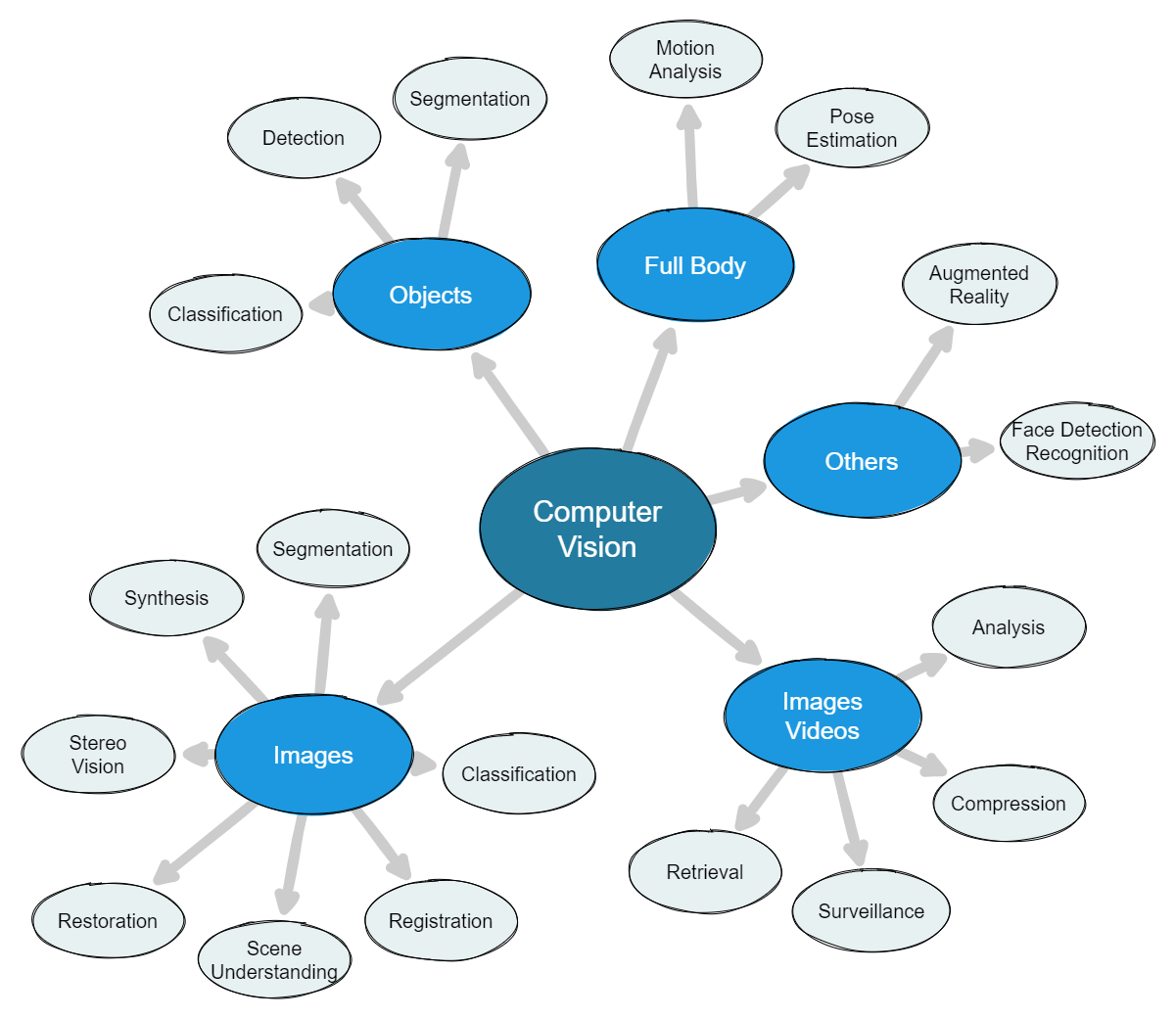Last Updated: 2/6/2023
Computer Vision - CV
What is Computer Vision?
Computer vision is a field of artificial intelligence and computer science that includes object recognition, image analysis, and scene understanding. In simple words, computer vision is a way for computers to "see" and understand pictures and videos, just like how our eyes see and understand things around us. It helps computers realize what's happening in the pictures and videos and allow them to make decisions based on what they see! Computer vision is a field of artificial intelligence and computer science that includes object recognition, image analysis, scene understanding, and more.
Computer vision is used in self-driving cars to understand and avoid obstacles on the road. It is also used in video games to make the characters move and interact with their environment as a real person would.
The process of computer vision is like solving a puzzle. The computer takes a picture or a video and then breaks it down into tiny pieces, just like how we might divide a puzzle into smaller pieces to make it easier to solve. Next, the computer looks at the tiny pieces and tries to figure out what they are and how they fit together, similar to how we look at puzzle pieces and try to figure out what the final picture is. Finally, the computer makes a decision based on what it sees, like a robot moving in a specific direction based on visual cues it receives.
Every computer vision process usually involves the following steps:
- Acquire an image or video (also known as the "input").
- Pre-process the input, which may include tasks such as noise reduction, image enhancement, and color space conversion.
- Extract features from the pre-processed input, including edges, corners, and other elements used to distinguish one object from another.
- Analyze the features to make a decision or a prediction based on the content of the input. This step may involve training a machine learning model on a dataset of labeled examples.
Computer Vision in Real Life
- Self-driving cars: Computer vision can be used in autonomous vehicles, allowing them to see and avoid obstacles on the road, like pedestrians, other vehicles, and even animals. It also helps the car to recognize traffic lights and road signs to know when to stop or go. Imagine that the car is like a driver, but instead of eyes, it uses cameras and sensors to see, and it's a computer program that processes the information to make the right decisions.
- Robotics: Computer vision can be used in robots to navigate and avoid obstacles in their environment, such as walls and furniture. It helps robots recognize and interact with objects, such as picking up, manipulating, or identifying a specific object by its shape, color, or texture. So typically includes object recognition and visual SLAM (simultaneous localization and mapping).
- Surveillance systems: Computer vision enables surveillance systems to detect and track people and objects without human intervention automatically, including object detection, face recognition, and behavior analysis.
- Medical imaging: Computer vision assists doctors in diagnosing and treating illnesses, using techniques like image segmentation, registration, and image analysis.
- Augmented reality: Computer vision enables augmented reality systems to understand and interact with the real world. Thanks to object recognition, marker tracking, and scene understanding.
- Face recognition: Computer vision-based face recognition systems are used in many security systems for identification and authorization in various devices and applications like mobile, laptops, online services, etc.
- Industrial Inspection: Computer vision is used in many manufacturing and assembly lines to perform inspections of products and components, such as quality control, detecting defects, or measuring dimensions.
- Agriculture: Computer vision is used in precision agriculture to improve crop yields with tasks such as plant counting, disease detection, and crop monitoring.
Computer Vision Problems

- Image Classification: categorizes an image into one of several predefined classes based on its features and characteristics.
- Object Detection: identifies and locates objects in an image or video.
- Object Segmentation: separates an object from the background in an image.
- Image Restoration: restore a degraded or damaged image to its original form.
- Face Detection and Recognition: detects and recognizes human faces in images and videos.
- Image Registration: aligns two or more images to a common reference frame.
- Stereo Vision: estimates the depth of objects in an image based on the differences in the images captured by two cameras.
- Motion Analysis: detects and tracks moving objects in a video sequence.
- Image Segmentation: divides an image into multiple segments, each corresponding to a different object or region.
- Scene Understanding: analyzes and interprets the contents of an image or video to understand the relationships between objects and their contexts.
- Pose Estimation: determines the position and orientation of objects in an image or video.
- Image and Video Compression: reduces the size of images and videos while preserving their quality.
- Image Synthesis: generates new images based on existing photos or data.
- Image and Video Retrieval: searches and retrieves images and videos based on their content and metadata.
- Image and Video Surveillance: detects and tracks objects and events in real-time using cameras and other sensors.
- Image and Video Analysis: extract information and insights from images and videos, such as image classification, object detection, and scene understanding.
- Augmented Reality and Virtual Reality: applications that use computer vision to enhance or replace the real-world view with digital content.
Extra Resources
Books
Videos